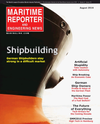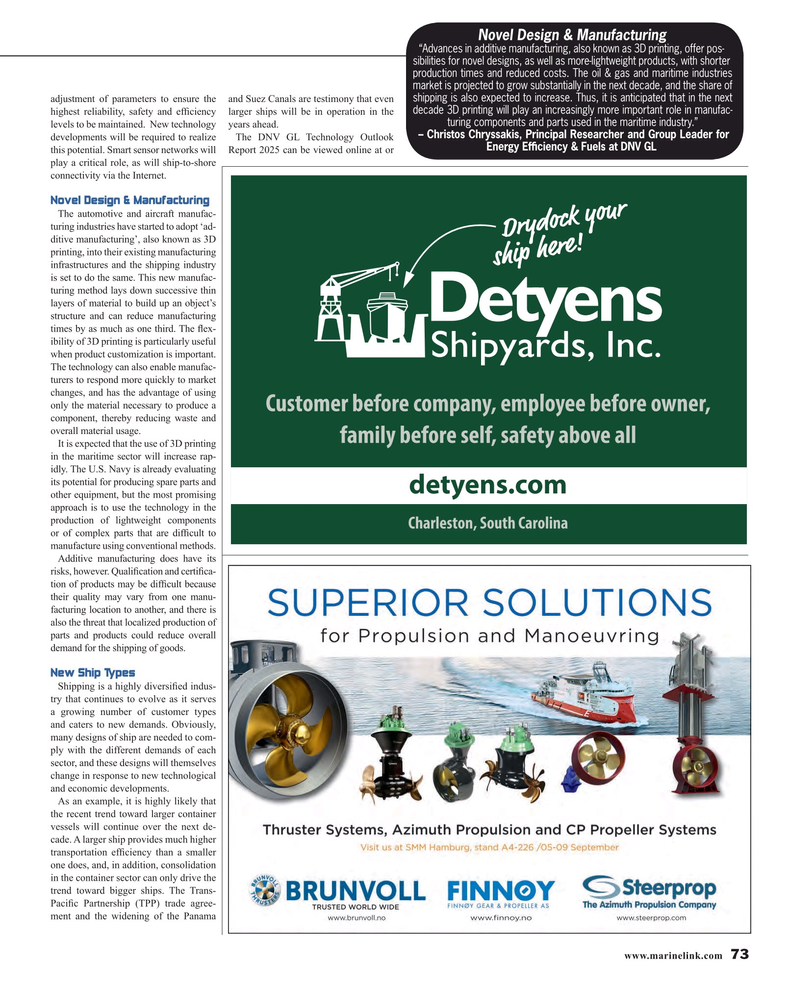
Page 73: of Maritime Reporter Magazine (August 2016)
The Shipyard Edition
Read this page in Pdf, Flash or Html5 edition of August 2016 Maritime Reporter Magazine
Novel Design & Manufacturing “Advances in additive manufacturing, also known as 3D printing, offer pos- sibilities for novel designs, as well as more-lightweight products, with shorter production times and reduced costs. The oil & gas and maritime industries market is projected to grow substantially in the next decade, and the share of shipping is also expected to increase. Thus, it is anticipated that in the next adjustment of parameters to ensure the and Suez Canals are testimony that even downloaded from www.dnvgl.com decade 3D printing will play an increasingly more important role in manufac- highest reliability, safety and ef? ciency larger ships will be in operation in the turing components and parts used in the maritime industry.” levels to be maintained. New technology years ahead.
– Christos Chryssakis, Principal Researcher and Group Leader for developments will be required to realize The DNV GL Technology Outlook
Energy Ef? ciency & Fuels at DNV GL this potential. Smart sensor networks will Report 2025 can be viewed online at or play a critical role, as will ship-to-shore connectivity via the Internet.
Novel Design & Manufacturing
The automotive and aircraft manufac- turing industries have started to adopt ‘ad- Drydock your ditive manufacturing’, also known as 3D printing, into their existing manufacturing ship here!
infrastructures and the shipping industry is set to do the same. This new manufac- turing method lays down successive thin layers of material to build up an object’s structure and can reduce manufacturing times by as much as one third. The ? ex- ibility of 3D printing is particularly useful when product customization is important.
The technology can also enable manufac- turers to respond more quickly to market changes, and has the advantage of using only the material necessary to produce a component, thereby reducing waste and overall material usage.
family before self, safety above all
It is expected that the use of 3D printing in the maritime sector will increase rap- idly. The U.S. Navy is already evaluating its potential for producing spare parts and detyens.com other equipment, but the most promising approach is to use the technology in the production of lightweight components
Charleston, South Carolina or of complex parts that are dif? cult to manufacture using conventional methods.
Additive manufacturing does have its risks, however. Quali? cation and certi? ca- tion of products may be dif? cult because their quality may vary from one manu- facturing location to another, and there is also the threat that localized production of parts and products could reduce overall demand for the shipping of goods.
New Ship Types
Shipping is a highly diversi? ed indus- try that continues to evolve as it serves a growing number of customer types and caters to new demands. Obviously, many designs of ship are needed to com- ply with the different demands of each sector, and these designs will themselves change in response to new technological and economic developments.
As an example, it is highly likely that the recent trend toward larger container vessels will continue over the next de- cade. A larger ship provides much higher transportation ef? ciency than a smaller one does, and, in addition, consolidation in the container sector can only drive the trend toward bigger ships. The Trans-
Paci? c Partnership (TPP) trade agree- ment and the widening of the Panama www.marinelink.com 73
MR #8 (66-73).indd 73 8/1/2016 4:06:54 PM

 72
72

 74
74
